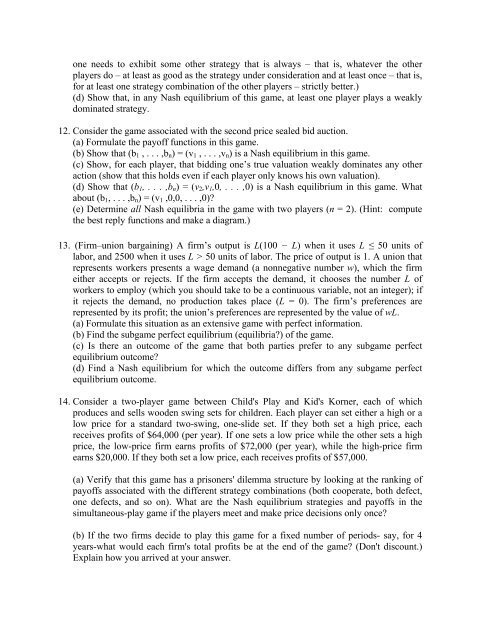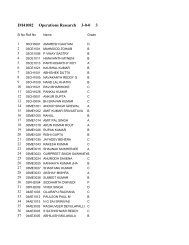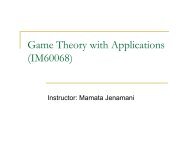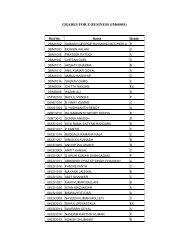Assignment 1 Subject Name: Game Theory with Applications
Assignment 1 Subject Name: Game Theory with Applications
Assignment 1 Subject Name: Game Theory with Applications
You also want an ePaper? Increase the reach of your titles
YUMPU automatically turns print PDFs into web optimized ePapers that Google loves.
one needs to exhibit some other strategy that is always – that is, whatever the other<br />
players do – at least as good as the strategy under consideration and at least once – that is,<br />
for at least one strategy combination of the other players – strictly better.)<br />
(d) Show that, in any Nash equilibrium of this game, at least one player plays a weakly<br />
dominated strategy.<br />
12. Consider the game associated <strong>with</strong> the second price sealed bid auction.<br />
(a) Formulate the payoff functions in this game.<br />
(b) Show that (b 1 , . . . ,b n ) = (v 1 , . . . ,v n ) is a Nash equilibrium in this game.<br />
(c) Show, for each player, that bidding one’s true valuation weakly dominates any other<br />
action (show that this holds even if each player only knows his own valuation).<br />
(d) Show that (b 1 , . . . ,b n ) = (v 2 ,v 1 ,0, . . . ,0) is a Nash equilibrium in this game. What<br />
about (b 1 , . . . ,b n ) = (v 1 ,0,0, . . . ,0)<br />
(e) Determine all Nash equilibria in the game <strong>with</strong> two players (n = 2). (Hint: compute<br />
the best reply functions and make a diagram.)<br />
13. (Firm–union bargaining) A firm’s output is L(100 − L) when it uses L ≤ 50 units of<br />
labor, and 2500 when it uses L > 50 units of labor. The price of output is 1. A union that<br />
represents workers presents a wage demand (a nonnegative number w), which the firm<br />
either accepts or rejects. If the firm accepts the demand, it chooses the number L of<br />
workers to employ (which you should take to be a continuous variable, not an integer); if<br />
it rejects the demand, no production takes place (L = 0). The firm’s preferences are<br />
represented by its profit; the union’s preferences are represented by the value of wL.<br />
(a) Formulate this situation as an extensive game <strong>with</strong> perfect information.<br />
(b) Find the subgame perfect equilibrium (equilibria) of the game.<br />
(c) Is there an outcome of the game that both parties prefer to any subgame perfect<br />
equilibrium outcome<br />
(d) Find a Nash equilibrium for which the outcome differs from any subgame perfect<br />
equilibrium outcome.<br />
14. Consider a two-player game between Child's Play and Kid's Korner, each of which<br />
produces and sells wooden swing sets for children. Each player can set either a high or a<br />
low price for a standard two-swing, one-slide set. If they both set a high price, each<br />
receives profits of $64,000 (per year). If one sets a low price while the other sets a high<br />
price, the low-price firm earns profits of $72,000 (per year), while the high-price firm<br />
earns $20,000. If they both set a low price, each receives profits of $57,000.<br />
(a) Verify that this game has a prisoners' dilemma structure by looking at the ranking of<br />
payoffs associated <strong>with</strong> the different strategy combinations (both cooperate, both defect,<br />
one defects, and so on). What are the Nash equilibrium strategies and payoffs in the<br />
simultaneous-play game if the players meet and make price decisions only once<br />
(b) If the two firms decide to play this game for a fixed number of periods- say, for 4<br />
years-what would each firm's total profits be at the end of the game (Don't discount.)<br />
Explain how you arrived at your answer.






